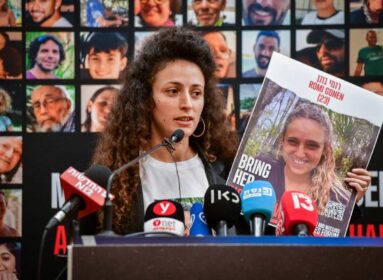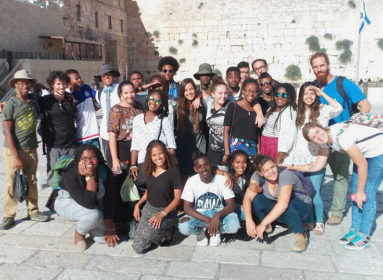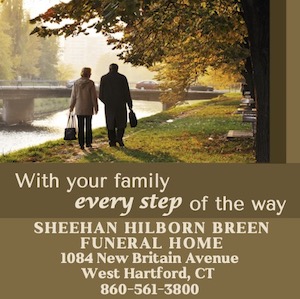By Cindy Mindell
 WEST HARTFORD – Cyma Shapiro was 46 when she decided to adopt a child. She had helped raise her husband’s two children from a previous marriage, now grown, and was ready for another round.
WEST HARTFORD – Cyma Shapiro was 46 when she decided to adopt a child. She had helped raise her husband’s two children from a previous marriage, now grown, and was ready for another round.
Shapiro and her husband traveled to Russia to adopt a one-year-old girl and returned there two years later to adopt a boy. She discovered The Maternal Is Political, an anthology of essays by mothers on the connection between motherhood and social change. Little did Shapiro know, the very act of becoming a mother would turn her into an activist.
“I began searching for answers to my own midlife mother conundrum – my choice to (re)start a family at an age when others were preparing for retirement, sending their children off to college, and reinventing themselves,” she writes in the introduction to her own newly published anthology, The Zen of Midlife Mothering. “I could find few role models to emulate and my wide sphere of friends were themselves at a loss for how to deal with our new life. Grappling with hormonal changes, aging parents, and my own ‘middle-age’ status, I could firmly say that for the first time in my adult life, I was completely and utterly lost.”
A Wethersfield native and longtime West Hartford resident, Shapiro had built a career as a realtor and journalist. She started a support group for mothers over 40, hoping that the members would be able to discuss many shared experiences. But the opposite was true and the group fizzled when the women failed to bond. Shapiro decided to explore more deeply the new phenomenon being described in the media as “new older mothering” and “midlife mothering.”
“I saw this as both a challenge and an important distraction from my own pain and confusion,” she writes. “In the end, I came to realize that I was ultimately hoping to find myself.”
Over the next three years, Shapiro sought out and interviewed women throughout the U.S. and Canada – in the end, 60 in all – about their respective journeys to motherhood late in life. Shapiro gathered an eclectic group, ranging in age from 41 to 65, and from every socio-economic class, race, religion, creed, and family model. She asked each woman about the decision to become a midlife mother, how her friends and family had reacted, and whether she would have pursued the same path if she had her life to live over again. What began as a potential book project evolved into a photo exhibition, the first of its kind in North America.
The time was right to put a public face on the phenomenon Shapiro was now a part of. Since the late ‘90s, thanks to medical breakthroughs, socio-economic freedoms, and a breakdown of tradition family mores, the number of women over 40 giving birth to their first child has jumped from one in 600 to one in 77. By Shapiro’s count, the burgeoning demographic numbers more than one million.
The stories ran the gamut: unassisted reproduction, in-vitro fertilization, surrogacy, adoption, fostering, guardianship, and blending stepfamilies. Some of the women were single; some already had raised children. No matter the path taken, Shapiro discovered one fundamental, unwavering truth: “they all shared an undeniable passion just to become a mother,” she says.
The photo exhibit “Nurture: Stories of New Midlife Mothers” opened at the Hartford Seminary Women’s Leadership Institute in November 2010. After traveling to a dozen locations throughout North America, including several JCCs, the exhibition has returned to the Hartford Seminary, and is on display through July. The show features 26 of the women Shapiro interviewed, photographed in family portraits by former West Hartford resident Shana Sureck on the East Coast and Tracy Cianflone on the West Coast – both incidentally midlife mothers themselves. Shapiro says that the project budget ran out before she could find a photographer to work with her interviewees between the coasts.
The show is more than an album of family portraits; it’s the tool of an activist. Since its debut, Shapiro has come to see the collection of photographs and stories as a way to dispel myths about middle age, reveal the growing trend of women choosing midlife motherhood, offer role models to subsequent generations of women, and provide this growing new population of older mothers with a voice, face, and forum. “Nurture” spawned a blog and website, MidlifeMothers.org.
The exhibition and blog attracted national attention, so much so that Shapiro launched MotheringintheMiddle.com, an online meeting-place to discuss midlife motherhood (and fatherhood). Over three years, the site racked up some 700 essays by 110 contributors from around the world. In December, Shapiro published 50 of the posts as The Zen of Midlife Mothering (CreateSpace Independent Publishing Platform), the first anthology of its kind written by and for midlife parents.
Shapiro shares her own story in the book. “Nine years ago, I felt I had no choice but to find, pursue, and finally get my children,” she writes. “My journeys to Russia became a spiritual epiphany, ending in two adoptions. I could finally fully embrace the children whom I fervently believed were meant to be mine, and who were just waiting for me to claim them. I cringed when people repeatedly told me how I’d ‘saved them.’ The truth revealed: It was they who saved me. I remained puzzled when I was told that I was ‘such a role model,’ when all I wanted to do was to live my life, as a mother.”
Shapiro asked two things of each writer in the anthology: to write their “truth,” and to write from the heart. “I know I speak for so many others when I say that we will stop at nothing – absolutely, positively nothing – to become mothers, when our time is right,” she writes.
Among the contributors to The Zen of Midlife Mothering is Shana Sureck, the East Coast photographer for the “Nurture” exhibition. Now 51, Sureck is an award-winning photojournalist who worked at The Hartford Courant for 20 years. A longtime West Hartford resident, she relocated to Northampton, Mass. in 2009 and freelances throughout New England and New York for editorial publications, non-profit organizations, and educational institutions.
At age 40, Sureck gave birth to her daughter, Tali, and raised her alone. She now lives with her partner, daughter, and two stepsons.
“As a photographer, I’ve always been interested in how we make meaning in our lives and come to the decisions we do,” Sureck says. “My whole journey of infertility and things not working out quite as I’d imagined when I was younger made me even more fascinated in people who want to become mothers and what it takes to do that.”
With the straightforward honesty that is the hallmark of the book’s contributors, Sureck tells of a difficult journey from artificial insemination to ectopic pregnancy. “I was told to end the pregnancy and I said, ‘No way,’” she recalls. “I kept trying to talk to friends about what to do and just couldn’t make peace with it. Late one night, I called my teacher, Rabbi Shlomo Yaffe [former spiritual leader of Agudas Achim Synagogue in West Hartford], and he said to come over right away. He told me, ‘You have to take care of this: the life of the mother is more important than the life of the child. Every soul has a purpose and whether this soul lasts six weeks or 100 years, whatever its purpose has been achieved.’ That was what allowed me to say, ‘OK, I can do this.’”
Sureck describes the road to motherhood as “a very Jewish journey.”
Like the biblical Hannah, a childless woman who prayed for a son and promised to raise him to serve God, Sureck found herself weeping just before Shabbat began, vowing to raise a child to love God. After lighting candles, she returned to check on a pregnancy test to find two tiny lines – an indication that she was pregnant.
Sureck’s Jewish community in West Hartford – the Kehilat Chaverim chavurah, and P’nai Or congregation – made a baby quilt of squares bearing spiritual messages. Sureck kept her promise, sending Tali to LGA – Schechter, a Jewish day school in Northampton, Mass. Tali just celebrated her bat mitzvah and still sleeps under the blanket, Sureck says.
Shapiro has brought these stories and her own work to a national and international stage through articles on websites including Huffington Post, Psychology Today, and Imago International. She has appeared on national and international radio talk shows and at women’s conferences, and will teach an adult education course in the fall.
“This work is about making life choices that work for you and redefining the family model going into the 21st century,” she says. “It’s a way to keep offering the world the opportunity to read any number of voices of mothers and fathers choosing parenthood over 40.”
Shapiro admits that she’s an accidental activist.
“I set out to show the world who we are and I wanted to dispel all the myths,” she says. “I wanted people to understand why we made these choices and how friends and family reacted. It morphed into the desire to dispel myths about women in middle age and provide role models for younger women. I believe that new older motherhood is the newest chapter in the women’s movement – the emerging new face of middle age and women.”
Comments? email cindym@jewishledger.com.
Michelle Meyer’s story
After numerous attempts to conceive, Michelle Meyer, then in her mid-40s, turned to adoption. Within the span of three years, the West Hartford woman was offered several children, only to be then turned down without explanation. She later learned that as a single mother she had been relegated to the bottom of the list. Then, one day she was selected to be the mother of a nearly three-year-old Hispanic boy. Now, Michelle is seeking a sibling for Jake, now 11.
“He desperately wants to be a big brother,” she says.
The following is Meyer’s narrative text included with NURTURE: Stories of New Midlife Mothers
I always anticipated being a mom. I never felt that it wouldn’t happen. I always anticipated meeting someone and getting married and having a child. I thought, ‘Okay, I’m only 30, it will happen. It’s not a big deal.’ And then 35 came. And then 40 came. And then all of a sudden, I think at 40, I had a wake-up call, like, ‘Hmm. I’m not married.’ Then, I had the miscarriage, and thought, ‘Hey, I’m still not married!’ I was in another city by then and I started thinking about alternatives: ‘What if I don’t find a partner?’
I grew up in the ‘60s and ‘70s with Gloria Steinem, and people were always saying ‘you can do what you want, be what you want. You don’t have to be any norm.’ If I had any other way of doing this, I would have. But I didn’t want to get where I am now (adopting) and not try (all the other methods). As much as I love my son, I do feel like I’ve missed something (by not becoming pregnant) and that’s such a big, big experience in life, by not feeling him grow inside me. It doesn’t mean I love him any less.
Right after (the adoption), my social worker asked what I thought about this. I thought, ‘What do I think? I’m in love. I’m blessed.’ But, I said, ‘I do have a question: Why me?’ She responded with puzzlement. And, I said, ‘For three years I’ve been getting phone calls weekly, sometimes daily, and I pretty much said ‘yes’ to everything and never heard back again. All a sudden, I get the call (for Jake) and I want to know, why did you feel I was the best family for this child? I’m Jewish, I’m single, I work full time…’ The social worker replied, “What does it have anything to do with being single? I was raised by a single mom.” And, that was the light bulb for me. Okay, so the heavens were conspiring for me to be a mom. If she had not been his social worker, I would not be his mother.
I remember driving to my house (the first time) with him in the back seat. He was kind of quiet. And, I remembered thinking about how I read about other parents saying (that with children), “your heart’s so full that it’s going to burst.” Now, I understand what they mean. It was such an unbelievable feeling. I would have done this sooner. Maybe I wasted too much time trying to do this naturally. However, I wouldn’t have gotten Jake and I can’t imagine my life without him.
In Praise of Older Mothers
By Rabbi Stephen Fuchs
The fifth of the seven traditional blessings recited at a Jewish wedding proclaims: “May the (Akarah) barren woman rejoice with happiness in the company of her children.” The blessing is an acknowledgement and an affirmation of the recurring theme in the Hebrew Bible of the woman beyond normal child bearing age who has children. While the term Akarah means “barren woman,” it is used exclusively – and in no fewer than seven cases – in the Hebrew Bible to refer to a woman who has children well beyond the normal child bearing age.
The first of these is Sarah, Abraham’s wife and co-partner in the sacred Covenant upon which all of Jewish religious thought bases itself. In that Covenant God promises Abraham and Sarah and their descendants: protection, children, permanence as a people and the land of Israel. But those promises are conditional. To merit them we (as God said directly to Abraham) must: “Be a blessing in our lives (Gn 12:2), “Walk in God’s ways and be worthy (Gn 17:1) and fill the world with tzedakah, “righteousness” and Mishpat, “justice.” (Gn 18: 19)
Sarah, of course, feels completely left out because she has no children. In despair, Abraham cries out to God: “What reward can you give me seeing that I shall die childless?” (Gn 15:2). Desperately Sarah invites Abraham to use humanity’s first known fertility procedure – having a child with a surrogate – so that she can be a mother. She invites Abraham to cohabit with her handmaiden, Hagar who bears Ishmael. Eventually –at the age of 90 – Sarah herself gives birth to Isaac.
Isaac in turn marries Rebecca who is an Akarah for 20 years until she conceives and bears twins, Esau and Jacob. Jacob marries four women, but really only loves one, Rachel. And Rachel is also an Akarah for many years before giving birth to Joseph. Three of Judaism’s first four matriarchs, then, did not become mothers until middle age, and in Sarah’s case, well beyond. Leah, who bore children shortly after her marriage, is the only exception.
Much later, Samuel, arguably the second most significant figure (behind Moses) in the Hebrew Bible is born to Hannah who is also an Akarah. The (unnamed) mother of Samson, the mighty warrior who delivers Israel from the Philistines is also an Akarah. Finally, the great prophets Elijah and Elisha each invoke God’s help to intervened and help two different women (both identified by the term Akarah) to give birth.
Hannah and Samson’s mother share a vital common trait. They are steadfast, understanding and faithful, while the men around them (their respective husbands and Eli the High Priest) are clueless to the meanings of their divine interactions.
What modern lessons are we to glean from these disparate but related biblical accounts? The fact that a disproportionate number of the Bible’s great figures are the offspring of an Akarah must be seen as a compliment to women who give birth during middle age or beyond. The many biblical Akarot (plural of Akarah) who give birth is a testament to the correlation between desire to have a child and the level of nurture and love that child will receive.
We all are all too aware of the many children born almost at random to young women who have neither the emotional maturity or the financial wherewithal, or the family support to become mothers. Often their children are the results of careless “accidents.”
The middle aged woman who gives birth, by contrast, almost always does so with great intentionality and desire to become a parent. More often than not the children of such women are eagerly desired, lovingly nurtured and raised in a home where finances are more than adequate to see to the child’s needs.
The Bible in its praise of middle aged mothers goes even further. It sees their years of desire and longing as worthy of special reward. They not only give birth, but they “rejoice with happiness in the company of their children” who are destined to play an important role in the history of the Israelite people.
Rabbi Stephen L. Fuchs is rabbi emeritus of Congregation Beth Israel in West Hartford. He was also formerly president of the World Union for Progressive Judaism.
This article first appeared at www.motheringinthemiddle.com.








 Southern New England Jewish Ledger
Southern New England Jewish Ledger













